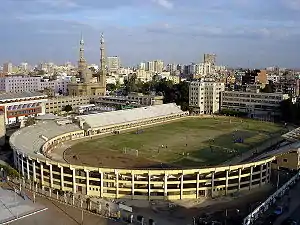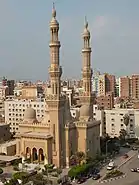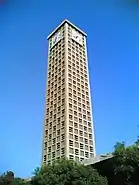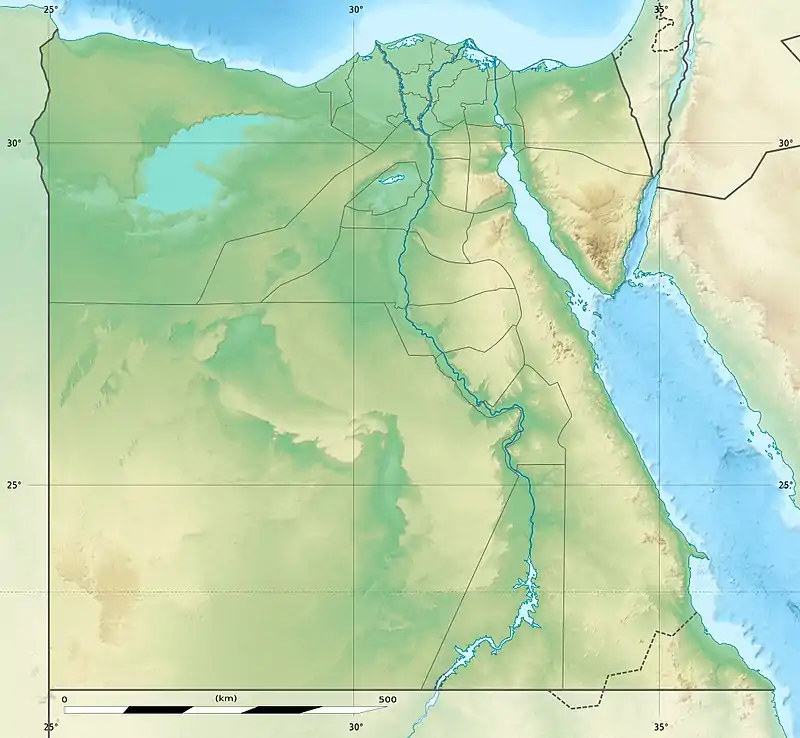Zagazig
Zagazig (Arabic: الزقازيق az-Zaqāzīq Egyptian Arabic pronunciation: [ez.zæʔæˈziːʔ], rural: [ez.zæɡæˈziːɡ]) is a city in Lower Egypt. Situated in the eastern part of the Nile delta, it is the capital of the governorate of Sharqia.
Zagazig
الزقازيق | |
|---|---|
    Overview of Zagazig | |
 Zagazig Location within Egypt | |
| Coordinates: 30°34′N 31°30′E | |
| Country | |
| Governorate | Sharqia |
| Founded | 1830 |
| Population (2018) | |
| • Total | 529,200 |
| Time zone | UTC+2 (EET) |
| Area code(s) | +(20) 55 |
It is located on the Muweis Canal and is a hub of the corn and cotton trade. There is a museum of antiquities, the Sharkeya National Museum (sometimes called the Amed Orabi Museum, at Herriat Raznah) that contains many important archaeological exhibits (currently closed for restoration).[1]
Zagazig University, one of the largest universities in Egypt, is also located in the city, with colleges in different fields of science and arts. The Archaeological Museum of the University of Zagazig exhibits significant finds from the nearby sites, Bubastis (Tell Basta) and Kufur Nigm.[2] Also there is a branch for Al-Azhar University, the largest Islamic university in the world.
Zagazig is the birthplace of famous Coptic Egyptian journalist, philosopher and social critic, Salama Moussa.
The most notable streets in Zagazig are Farouk Street, Government Street, and El Kawmia Street.
History
The city was found in the 19th century on a place of a village called Nazlat az-Zaqāzīq which was named after the Zaqzuq family.[3] The family's name itself comes from a dialectal word zaqzuq or ziqziq which means "a small creature" (e.g. a fish or a mouse)[4] and comes from a Coptic word ϫⲉⲕϫⲓⲕ "ant or other insect".[5][6]
The ruins of the ancient Egyptian city of Bubastis are located 3 kilometres (1.9 mi) southeast of town. Bubastis was the ancient capital of the 18th nome, and is home to the feast celebrating the cat goddess Bastet.
Bubastis is the Greek version of the Egyptian language name Pr-Bastet "House [Temple] of Bastet". Bubastis became the capital of Egypt in the 22nd and 23rd Dynasties. There are remains of the temples built by Osorkon II and Nectanebo II. Catacombs where the sacred cats were buried are located behind an Old Kingdom chapel remains that are from the period of Pepi I Meryre.
Climate
Köppen-Geiger climate classification system classifies its climate as hot desert (BWh), as the rest of Egypt.
| Climate data for Zagazig | |||||||||||||
|---|---|---|---|---|---|---|---|---|---|---|---|---|---|
| Month | Jan | Feb | Mar | Apr | May | Jun | Jul | Aug | Sep | Oct | Nov | Dec | Year |
| Average high °C (°F) | 17.9 (64.2) |
19.4 (66.9) |
22.7 (72.9) |
26.9 (80.4) |
31.2 (88.2) |
33.6 (92.5) |
33.6 (92.5) |
33.5 (92.3) |
31.4 (88.5) |
29.3 (84.7) |
24.5 (76.1) |
19.8 (67.6) |
27.0 (80.6) |
| Daily mean °C (°F) | 11.9 (53.4) |
13 (55) |
15.7 (60.3) |
19.2 (66.6) |
23.2 (73.8) |
26 (79) |
26.9 (80.4) |
26.8 (80.2) |
24.7 (76.5) |
22.6 (72.7) |
18.8 (65.8) |
13.9 (57.0) |
20.2 (68.4) |
| Average low °C (°F) | 5.9 (42.6) |
6.8 (44.2) |
8.8 (47.8) |
11.6 (52.9) |
15.2 (59.4) |
18.4 (65.1) |
20.2 (68.4) |
20.1 (68.2) |
18 (64) |
16 (61) |
13.2 (55.8) |
8 (46) |
13.5 (56.3) |
| Average precipitation mm (inches) | 8 (0.3) |
4 (0.2) |
4 (0.2) |
2 (0.1) |
2 (0.1) |
0 (0) |
0 (0) |
0 (0) |
0 (0) |
2 (0.1) |
5 (0.2) |
6 (0.2) |
33 (1.4) |
| Source: Climate-Data.org[7] | |||||||||||||
Notable people
- Abaza family, the largest family in Sharqia and Egypt's largest Circassian community.[8][9]
- Abdelhalim Hafez, Egyptian singer and actor
- Ahmed Orabi, colonel who led the revolt against the British in 1882
- Carmen Suleiman, singer
- Mohamed Morsi, the fifth president of Egypt
- Salama Moussa, Coptic Egyptian journalist, philosopher and social critic
- Ahmed Zaki, actor
- John Traicos, International cricketer of Greek origin
- Rushdy Abaza, actor
- Fekry Pasha Abaza, journalist and political activist
- Elhenawy Pasha Family, one of the greatest families in zagazig
- Elnahal Family, one of the greatest and famous families in zagazig
See also
References
- Catalogue: Mohamed I. Bakr, Helmut Brandl, Faye Kalloniatis (eds.): Egyptian Antiquities from the Eastern Nile Delta. ʾĀṯār misrīya (Museums in the Nile Delta. Vol. 2). Opaion, Cairo/ Berlin 2014, ISBN 978-3-00-045318-2.
- Catalogue: M. I. Bakr, H. Brandl, F. Kalloniatis (eds.): Egyptian Antiquities from Kufur Nigm and Bubastis. ʾĀṯār misrīya (Museums in the Nile Delta. Vol. 1). Opaion, Cairo/ Berlin 2010, ISBN 978-3-00-033509-9.
- رمزي, محمد. القاموس الجغرافي للبلاد المصرية. pp. 89–92.
- Behnstedt, Peter & Woidich, Manfred (1994). Die ägyptisch-arabischen Dialekte. Band 4: Glossar Arabisch-Deutsch. Wiesbaden. p. 188.CS1 maint: multiple names: authors list (link)
- "Coptic Dictionary Online". coptic-dictionary.org. Retrieved 11 June 2020.
- Sobhy, Georgy (1950). Common words in the spoken Arabic of Egypt, of Greek or Coptic origin.
- "Climate: Al-Zaqaziq - Climate graph, Temperature graph, Climate table". Climate-Data.org. Retrieved 13 August 2013.
- "عائلات تحكم مصر.. 1 ـ عائلة الباشوات". Albawabhnews.com. Retrieved 15 October 2017.
- "Archived copy". Archived from the original on 27 December 2016. Retrieved 6 December 2016.CS1 maint: archived copy as title (link)
External links
| Wikimedia Commons has media related to Zagazig. |
- LookLex: Egypt: Zagazig
- Chisholm, Hugh, ed. (1911). . Encyclopædia Britannica (11th ed.). Cambridge University Press.